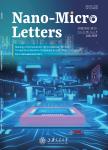Tailoring Classical Conditioning Behavior in TiO_(2) Nanowires:ZnO QDs-Based Optoelectronic Memristors for Neuromorphic Hardware
作者机构:School of Information Science and EngineeringUniversity of JinanJinan 250022People’s Republic of China RFIC CentreNDAC CentreKwangwoon UniversityNowon-guSeoul 139-701South Korea Department of Electronics EngineeringKwangwoon UniversityNowon-GuSeoul 139-701South Korea School of MicroelectronicsShandong UniversityJinan 250101People’s Republic of China Department of Molecular Medicine and Biopharmaceutical SciencesSeoul National UniversitySeoul 08826South Korea
出 版 物:《Nano-Micro Letters》 (纳微快报(英文版))
年 卷 期:2024年第16卷第7期
页 面:265-280页
核心收录:
学科分类:080903[工学-微电子学与固体电子学] 0809[工学-电子科学与技术(可授工学、理学学位)] 07[理学] 08[工学] 070205[理学-凝聚态物理] 080501[工学-材料物理与化学] 0805[工学-材料科学与工程(可授工学、理学学位)] 0703[理学-化学] 0812[工学-计算机科学与技术(可授工学、理学学位)] 0702[理学-物理学]
基 金:This work was supported by the Jinan City-University Integrated Development Strategy Project under Grant(JNSX2023017) National Research Foundation of Korea(NRF)grant funded by the Korea government(MIST)(RS-2023-00302751) by the National Research Foundation of Korea(NRF)funded by the Ministry of Education under Grants 2018R1A6A1A03025242 and 2018R1D1A1A09083353 by Qilu Young Scholar Program of Shandong University
主 题:Artificial intelligence Classical conditioning Neuromorphic computing Artificial visual memory Optoelectronic memristors ZnO Quantum dots
摘 要:Neuromorphic hardware equipped with associative learn-ing capabilities presents fascinating applications in the next generation of artificial ***,research into synaptic devices exhibiting complex associative learning behaviors is still ***,an optoelec-tronic memristor based on Ag/TiO_(2) Nanowires:ZnO Quantum dots/FTO was proposed and constructed to emulate the biological associative learning *** implementation of synaptic behaviors,including long and short-term plasticity,and learning-forgetting-relearning behaviors,were achieved in the device through the application of light and electrical *** the optoelectronic co-modulated characteristics,a simulation of neuromorphic computing was conducted,resulting in a handwriting digit recognition accuracy of 88.9%.Furthermore,a 3×7 memristor array was constructed,confirming its application in artificial visual *** importantly,complex biological associative learning behaviors were emulated by mapping the light and electrical stimuli into conditioned and unconditioned stimuli,*** training through associative pairs,reflexes could be triggered solely using light ***-sively,under specific optoelectronic signal applications,the four features of classical conditioning,namely acquisition,extinction,recovery,and generalization,were elegantly *** work provides an optoelectronic memristor with associative behavior capabilities,offering a pathway for advancing brain-machine interfaces,autonomous robots,and machine self-learning in the future.



